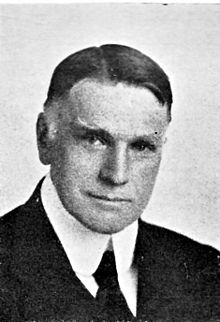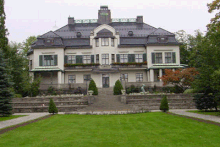Henrik Bull
Henrik Bull | |
|---|---|
 Henrik Bull | |
| Born | 28 March 1864 Christiania, Norway |
| Died | 2 June 1953 (aged 89) Oslo, Norway |
| Nationality | Norwegian |
| Occupation | Architect |
| Parent | Georg Andreas Bull |
| Relatives | Ole Bull (uncle) Knud Bull (uncle) Edvard Hagerup Bull (cousin) Schak Bull (cousin) |
Henrik Bull (28 March 1864 – 2 June 1953) was a Norwegian architect and designer. Among his works are the Paulus Church at


Early and personal life
Bull was born in Christiania as the son of architect Georg Andreas Bull and Emilie Constance Hjelm.[2] His father was among the major architects in the country, was chief building inspector in Christiania for forty years, and performed surveying and archeological research.[4] Bull married actress Mette Marie Berntsen Wang in 1905. He was a nephew of violinist Ole Bull[2] and Knud Bull, and a first cousin of judge and politician Edvard Hagerup Bull and architect Schak Bull.[5]
Works
Churches
Bull's first major commission was the
Monumental buildings
Bull designed three of the most important new buildings in Kristiania about 1900.
Jubilée exhibition 1914
Bull was responsible for the buildings at the 1914 Jubilee Exhibition in Kristiania. He also designed several of the exhibition buildings, including the bridge, the Machinery Hall, the Industry Hall. The buildings were demolished after the exhibition.[3]

Norway US embassy residence
Design work
- Bull also designed furniture and other utilitarian articles. One of his works, an exclusive dining room set, is located at the Norwegian Museum of Cultural History at Bygdøy. His most widespread works were the coins designed for Norges Bank in 1907 and in 1923-1924.[2]
- The
See also
Bibliography
Footnotes
- U.S. Department of State. Archived from the originalon 15 October 2011. Retrieved 9 November 2011.
Endnotes
- Store norske leksikon(in Norwegian). Oslo: Kunnskapsforlaget. Retrieved 16 April 2009.
- ^ a b c d e f g h Indahl, Trond. "Henrik Bull". In Helle, Knut (ed.). Norsk biografisk leksikon (in Norwegian). Oslo: Kunnskapsforlaget. Retrieved 16 April 2009.
- ^ a b c d e f g Steigan, Geir Tandberg (2001). "Henrik Bull (1864-1953)" (in Norwegian). Arc!. Retrieved 21 April 2009.
- ^ Torvanger, Åse Moe. "Georg Andreas Bull". In Helle, Knut (ed.). Norsk biografisk leksikon (in Norwegian). Oslo: Kunnskapsforlaget. Retrieved 20 April 2009.
- Store norske leksikon(in Norwegian). Oslo: Kunnskapsforlaget. Retrieved 4 April 2009.
- U.S. Department of State. Archived from the originalon 15 October 2011. Retrieved 9 November 2011.
